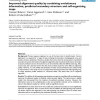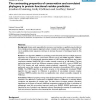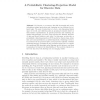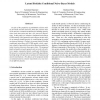36 search results - page 6 / 8 » A structural EM algorithm for phylogenetic inference |
BMCBI
2006
13 years 7 months ago
2006
Background: Protein sequence alignment is one of the basic tools in bioinformatics. Correct alignments are required for a range of tasks including the derivation of phylogenetic t...
BMCBI
2006
13 years 7 months ago
2006
Background: Since the publication of the first draft of the human genome in 2000, bioinformatic data have been accumulating at an overwhelming pace. Currently, more than 3 million...
BMCBI
2008
13 years 7 months ago
2008
Background: Amino acids responsible for structure, core function or specificity may be inferred from multiple protein sequence alignments where a limited set of residue types are ...
PKDD
2005
Springer
14 years 28 days ago
2005
Springer
For discrete co-occurrence data like documents and words, calculating optimal projections and clustering are two different but related tasks. The goal of projection is to find a ...
ICDM
2007
IEEE
14 years 1 months ago
2007
IEEE
In spite of the popularity of probabilistic mixture models for latent structure discovery from data, mixture models do not have a natural mechanism for handling sparsity, where ea...




